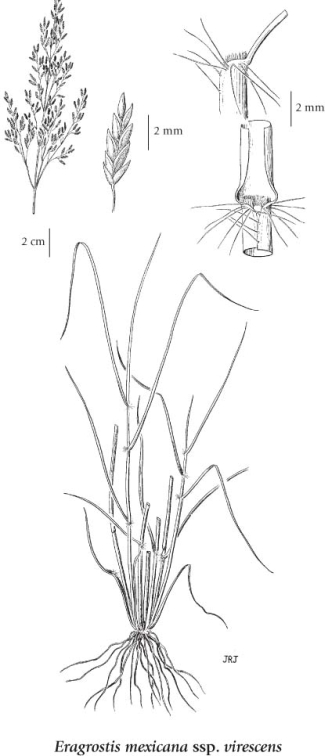Click on the image below to view an
expanded illustration for this species.

|
General:
Annual, tufted herb from fibrous roots; stems erect to decumbent, sometimes bent, 10-130 cm tall.
Leaves:
Sheaths smooth, sometimes with craterlike glands, pimply and hairy near the summit collars, the hairs up to 5 mm long; blades 5-25 cm long, (2) 3-7 (9) mm wide, flat, rough above, occasionally hairy near base, glabrous below; ligules 0.2-0.5 mm long, fringed.
Flowers:
Inflorescence an egg-shaped panicle (5) 10-40 cm long, (2) 4-18 cm wide, open to somewhat congested when immature, rachis angled and channeled; branches 3-12 (15) cm long, spreading 0-80degreefrom culm axis, solitary to whorled; secondary branches somewhat appressed; pedicels 1-6 (7) mm long, somewhat appressed, stiff; spikelets (4) 5-10 (11) mm long, 0.7-2.4 mm wide, 5- to 11- (15-) flowered, egg-shaped to linear, greyish-green to purplish; disarticulation of glumes first, then lemmas, paleas persistent; glumes 0.7-2 (2.3) mm long, subequal, egg-shaped to lanceolate, membranous; lemmas 1.2-2.4 mm long, egg-shaped, membranous, smooth or with a few hairs, greyish-green, tips sharp-pointed, lateral veins evident, often greenish; palea 1-2.2 mm long, papery, tips rounded to blunt; stamens 3; anthers 0.2-0.5 mm long, purplish; caryopses 0.5-0.8 (1) mm long, egg-shaped to rectangular-prismatic, one or both ends blunt, laterally compressed, shallow to deeply grooved on the upper surface (opposite the embryo), reddish-brown.
Notes:
Recently, the species has been separated into two distinct subspecies.
Source: The Illustrated Flora of British Columbia
|

